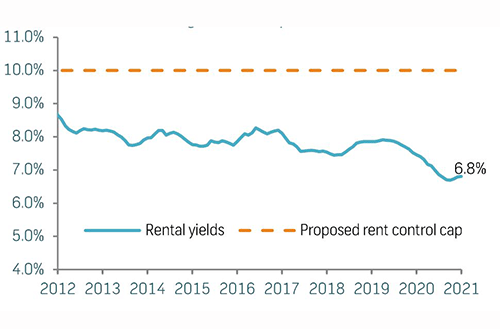As the impact of Covid-19 continues to cool off, combined with the re-opening of most economies, rental growth in Namibia is yet again back on its upward trajectory, recording smaller contractions over time. This, according to FNB’s latest rental index report, points to a gradual easing of the tight market conditions that have characterised the rental market over the past year and a half.
The report, compiled by FNB’s Market Research Manager Frans Uusiku shows that at the end of 2021, the 12-month average rental index growth posted a contraction of 0.7%. This represents a significant improvement when compared to a contraction of 2.1% recorded a year earlier. In dollar terms, the national weighted average rent came in at N$6 728 at the end of 2021 from N$6 747 a year ago. The more than three-bedrooms segment has consistently kept the rental growth momentum upbeat relative to other segments, with the 12-month average rent recorded at N$18 747 in December 2021. According to Uusiku, this reflects a staggering year-on-year rental growth of 9.7% and continues to reaffirm the growing relevance of the multi-family market as housing affordability issues linger. The emerging recovery in overall rental growth is also evident within the one-bedroom and the three-bedroom segments, as the decline in rents continues to soften. In effect, rental growth in these segments contracted by the same magnitude of 0.4% year-on-year (y/y), bringing the respective 12-month average rents to N$3 646 and N$9 689.
“The only segment which appears to have lagged the rental growth frontier is the two-bedroom segment which posted a 12-month average rent of N$6 424 over the same period. This reflects a year-on-year contraction of 6.7%, compared to a contraction of 2.3% realised over the same period of 2020. The suppressed rent growth within the two-bedroom segment is unsurprising given the inherent higher inventories and the resultant risk of tenants having greater bargaining power over landlords,” the report states.
Meanwhile, Uusiku noted that indeed, the stability of the housing market continues to define a high point of the Namibian rental market.
“However, with the current housing supply falling short of the demand gap due to high cost of land servicing that is further aggravated by constrained government spending, there is considerable scope for investors to deliver the ‘rent to own’ housing options across the regions at various price points. This is poised to move the needle in addressing the housing backlog,” Uusiku noted.
Looking at the regions, the report shows green shoots emerging but remaining limited to a few towns. The best performing towns in terms of rental growth are Rundu (70.1% y/y), Rehoboth (19.7% y/y), and Ongwediva (3.5% y/y). At the opposite end are Tsumeb (-45.5% y/y), Swakopmund (-28.1% y/y), Ondangwa (-26.7% y/y), (Okahandja -18.4% y/y), Walvis Bay (-16.8%) and Windhoek (-4.2% y/y). Uusiku attributes the lag to the large concentration of financial sector workers that are more likely to continue working on a hybrid or fully remote schedule.
Said Uusiku: “After a year-and-half of consistent declines in the rental index growth, the rental market appears to be improving due to cooling negotiability, and tenants seeking out for larger apartments. We believe stock expansion within the multi-family rental market will be a big factor in the recovery process.
The year ahead will be an important test for the Namibian rental market to see whether the same factors that have driven the recovery will continue to fuel the market, if new ones would emerge, or if the frenzy of activity will finally stabilize.”
He concluded that key possible headwinds are likely to revolve around elevated inflation, interest rates and a new wave of Covid-19 cases, which he expects to affect rent affordability and subsequently the pace of recovery.


